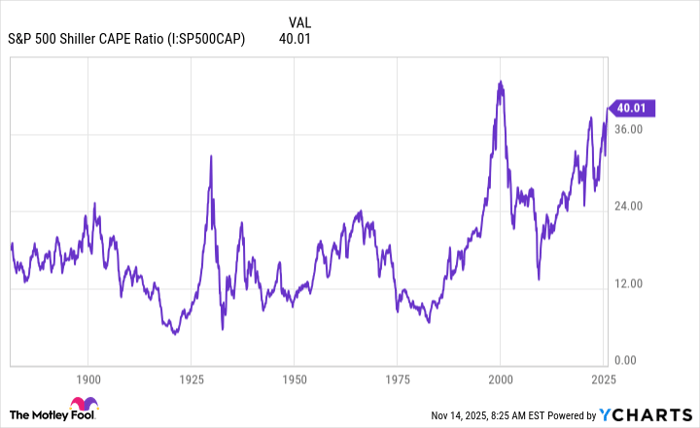The Stock Market Just Flashed a Signal We've Only Seen Once Before. Here's What History Says Could Come Next.
Key Points
The S&P 500 is heading for its third consecutive annual increase, led by gains in artificial intelligence stocks.
Investors are betting AI may supercharge earnings over time.
- 10 stocks we like better than S&P 500 Index ›
The S&P 500 has been flying high over the past few years amid investor optimism about artificial intelligence (AI) companies and an easier interest rate environment ahead. This helped the famous benchmark advance in the double-digits during each of the past two years, and this year, it's on track for another similar increase.
Investors have been excited about AI because it has the potential to revamp how companies work. By streamlining tasks, they may cut costs and supercharge growth, and AI also has what it takes to power discoveries. All of this is great news for earnings and stock performance -- and investors have been eager to get in early on this opportunity.
Where to invest $1,000 right now? Our analyst team just revealed what they believe are the 10 best stocks to buy right now, when you join Stock Advisor. See the stocks »
Meanwhile, the Federal Reserve started lowering interest rates last year and resumed action this fall, with cuts in September and October. Investors like this trend because lower rates support spending and make it easier for companies to borrow, all of which is favorable for growth-oriented companies.
While this sounds fantastic, trouble may be brewing under the surface -- and one particular piece of evidence puts it on display. The stock market just flashed a signal we've seen only once before, and here's what history says could come next.

Image source: Getty Images.
Nvidia and Palantir soar in the quadruple-digits
Before checking out this major clue, let's consider the momentum we've seen recently in the stock market. As mentioned, technology stocks involved in AI have powered gains, with names like Nvidia and Palantir Technologies advancing in the quadruple-digits over just a few years. And companies offering AI chips for rent through their cloud platforms have seen their prices explode higher. For example, CoreWeave and Nebius Group have advanced nearly 100% and more than 200%, respectively, this year.
All this is good news if you happen to be a shareholder, but excessive gains could lead to one thing we've seen unfold in recent months: Stocks have become more expensive. This brings me to the stock market signal we've seen only once before, and it has to do with the S&P 500 Shiller CAPE (cyclically adjusted price-to-earnings) ratio.
Stock price and earnings over time
This metric offers a solid valuation picture because it considers stock price and earnings over 10 years, accounting for fluctuations in the economy. The Shiller CAPE ratio just surpassed the level of 40, something it hasn't done since the dot-com bubble took shape back in 1999. That was the only other time it reached this level in the S&P 500's entire history -- whether you consider its existence as a 500-company index since the late 1950s or its earlier forms.

S&P 500 Shiller CAPE Ratio data by YCharts. CAPE Ratio = cyclically adjusted price-to-earnings ratio.
Now, the question is: What comes next? History shows us that after valuations have reached peaks -- such as during the dot-com bubble -- the S&P 500 has gone on to decline. For example, from December 1999 through December 2001, the S&P 500 slid about 20%. In November 2021, when the S&P 500 Shiller CAPE ratio surpassed 38, the index fell 20% in the following 12 months.
Clues from history
Now, considering that message from history, should we brace for a fall, especially considering the current mood in the market? As we've seen in recent days, investors have worried about an AI bubble taking shape, and that's led to declines in tech stocks as well as the overall market. For example, on Friday, the S&P 500 posted its worst performance in a month.
While it's very likely a more prolonged period of declines will come at some point -- the market never rises continually forever -- we don't know when it will happen. And we don't know exactly how much the S&P 500 will retreat.
But this dark cloud offers us a silver lining. Tech earnings have been strong -- from leaders such as Palantir and Amazon, among others -- and these players have spoken of ongoing demand for AI. All this supports the long-term AI growth story, suggesting a dip in prices of quality players may be a buying opportunity.
Finally, most important of all, history also tells us that declines never last forever, and the S&P 500, as well as great companies, always recover and go on to deliver a win, and this is fantastic news for long-term investors.
Should you invest $1,000 in S&P 500 Index right now?
Before you buy stock in S&P 500 Index, consider this:
The Motley Fool Stock Advisor analyst team just identified what they believe are the 10 best stocks for investors to buy now… and S&P 500 Index wasn’t one of them. The 10 stocks that made the cut could produce monster returns in the coming years.
Consider when Netflix made this list on December 17, 2004... if you invested $1,000 at the time of our recommendation, you’d have $599,784!* Or when Nvidia made this list on April 15, 2005... if you invested $1,000 at the time of our recommendation, you’d have $1,165,716!*
Now, it’s worth noting Stock Advisor’s total average return is 1,035% — a market-crushing outperformance compared to 191% for the S&P 500. Don’t miss out on the latest top 10 list, available when you join Stock Advisor.
See the 10 stocks »
*Stock Advisor returns as of November 10, 2025
Adria Cimino has positions in Amazon. The Motley Fool has positions in and recommends Amazon, Nvidia, and Palantir Technologies. The Motley Fool has a disclosure policy.



